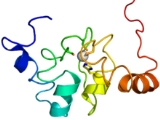
Inhibitor of apoptosis domain
Encyclopedia
The inhibitor of apoptosis domain -- also known as IAP repeat, Baculovirus Inhibitor of apoptosis protein Repeat, or BIR -- is a structural motif
found in protein
s with roles in apoptosis
, cytokine
production, and chromosome segregation
. Proteins containing BIR are known as inhibitor of apoptosis
proteins (IAPs), or BIR-containing proteins (BIRPs or BIRCs), and include BIRC1 (NAIP
), BIRC2
(cIAP1), BIRC3 (cIAP2), BIRC4 (xIAP
), BIRC5 (survivin
) and BIRC6
.
BIR domains belong to the zinc-finger domain family and characteristically have a number of invariant amino acid
residues, including 3 conserved cysteine
s and one conserved histidine
, which coordinate a zinc
ion. They are typically composed of 4-5 alpha helices
and a three-stranded beta sheet
.
Structural motif
In a chain-like biological molecule, such as a protein or nucleic acid, a structural motif is a supersecondary structure, which appears also in a variety of other molecules...
found in protein
Protein
Proteins are biochemical compounds consisting of one or more polypeptides typically folded into a globular or fibrous form, facilitating a biological function. A polypeptide is a single linear polymer chain of amino acids bonded together by peptide bonds between the carboxyl and amino groups of...
s with roles in apoptosis
Apoptosis
Apoptosis is the process of programmed cell death that may occur in multicellular organisms. Biochemical events lead to characteristic cell changes and death. These changes include blebbing, cell shrinkage, nuclear fragmentation, chromatin condensation, and chromosomal DNA fragmentation...
, cytokine
Cytokine
Cytokines are small cell-signaling protein molecules that are secreted by the glial cells of the nervous system and by numerous cells of the immune system and are a category of signaling molecules used extensively in intercellular communication...
production, and chromosome segregation
Chromosome segregation
Chromosome segregation is a step in cell reproduction or division, where chromosomes pair off with their similar homologous chromosome. In mitosis, a complete copy of each one is made. In meiosis, one chromosome from each pair migrates to opposite ends of the cell and the genes are split to make a...
. Proteins containing BIR are known as inhibitor of apoptosis
Inhibitor of apoptosis
The Inhibitors of Apoptosis are a family of functionally- and structurally-related proteins, which serve as endogenous inhibitors of programmed cell death . A common feature of all IAPs is the presence of a BIR in one to three copies...
proteins (IAPs), or BIR-containing proteins (BIRPs or BIRCs), and include BIRC1 (NAIP
NAIP
Baculoviral IAP repeat-containing protein 1 is a protein that in humans is encoded by the NAIP gene.-External links:...
), BIRC2
BIRC2
Baculoviral IAP repeat-containing protein 2 is a protein that in humans is encoded by the BIRC2 gene.-Interactions:...
(cIAP1), BIRC3 (cIAP2), BIRC4 (xIAP
XIAP
X-linked inhibitor of apoptosis protein also known as inhibitor of apoptosis protein 3 and baculoviral IAP repeat-containing protein 4 is a protein that in humans is encoded by the XIAP gene....
), BIRC5 (survivin
Survivin
Survivin, also called baculoviral inhibitor of apoptosis repeat-containing 5 or BIRC5, is a protein that, in humans, is encoded by the BIRC5 gene....
) and BIRC6
BIRC6
Baculoviral IAP repeat-containing protein 6 is a protein that in humans is encoded by the BIRC6 gene.-Further reading:...
.
BIR domains belong to the zinc-finger domain family and characteristically have a number of invariant amino acid
Amino acid
Amino acids are molecules containing an amine group, a carboxylic acid group and a side-chain that varies between different amino acids. The key elements of an amino acid are carbon, hydrogen, oxygen, and nitrogen...
residues, including 3 conserved cysteine
Cysteine
Cysteine is an α-amino acid with the chemical formula HO2CCHCH2SH. It is a non-essential amino acid, which means that it is biosynthesized in humans. Its codons are UGU and UGC. The side chain on cysteine is thiol, which is polar and thus cysteine is usually classified as a hydrophilic amino acid...
s and one conserved histidine
Histidine
Histidine Histidine, an essential amino acid, has a positively charged imidazole functional group. It is one of the 22 proteinogenic amino acids. Its codons are CAU and CAC. Histidine was first isolated by German physician Albrecht Kossel in 1896. Histidine is an essential amino acid in humans...
, which coordinate a zinc
Zinc
Zinc , or spelter , is a metallic chemical element; it has the symbol Zn and atomic number 30. It is the first element in group 12 of the periodic table. Zinc is, in some respects, chemically similar to magnesium, because its ion is of similar size and its only common oxidation state is +2...
ion. They are typically composed of 4-5 alpha helices
Alpha helix
A common motif in the secondary structure of proteins, the alpha helix is a right-handed coiled or spiral conformation, in which every backbone N-H group donates a hydrogen bond to the backbone C=O group of the amino acid four residues earlier...
and a three-stranded beta sheet
Beta sheet
The β sheet is the second form of regular secondary structure in proteins, only somewhat less common than the alpha helix. Beta sheets consist of beta strands connected laterally by at least two or three backbone hydrogen bonds, forming a generally twisted, pleated sheet...
.

